 |
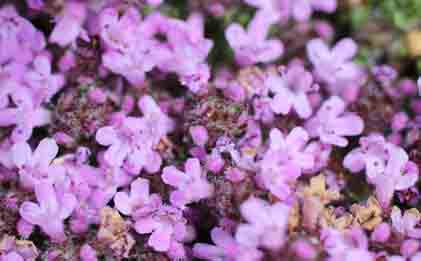 |
Plant w/Flowers |
Flowers |
Thyme, Creeping - Thymus serpyillum
Description
"Thymus serpyllum, known by the common names of Breckland thyme,[3] Breckland wild thyme, wild thyme, creeping thyme, or elfin thyme, is a species of flowering plant in the mint family Lamiaceae, native to most of Europe and North Africa. It is a low, usually prostrate subshrub growing to 2 cm (1 in) tall with creeping stems up to 10 cm (4 in) long. The oval evergreen leaves are 3–8 mm long. The strongly scented flowers are either lilac, pink-purple, magenta, or a rare white, all 4–6 mm long and produced in clusters. The hardy plant tolerates some pedestrian traffic and produces odors ranging from heavily herbal to lightly lemon, depending on the variety." (Wikipedia)
 |
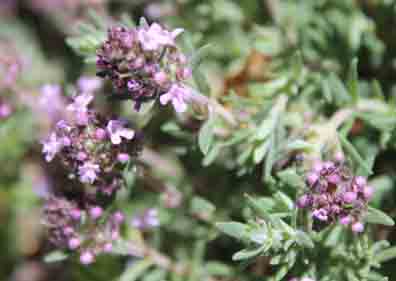 |
Plant w/Flowers |
Flowers |
Thyme, 'Juniper Leaf' - Thymus neiceffii 'Juniper Leaf'
Description
"Distinctive gray Juniper-style foliage makes this hard-to-find Thyme unique among other species in the genus. Stubby needle-shaped aromatic leaves tightly cling to reddish brown stems that lay flat on the ground, bearing bee friendly mauve-pink blooms in spring. Awash with soft pastel shades, Juniper Thyme can be threaded between pavers plus draped over rock work or container edges." (diggingdog.com)
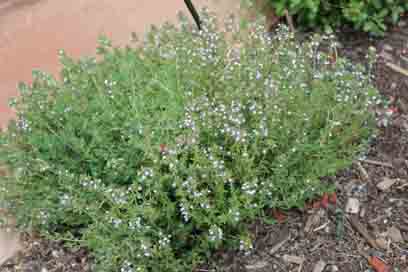 |
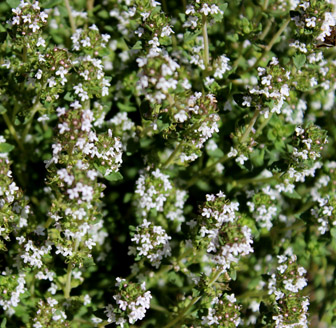 |
Thyme, English - Thymus vulgaris
Description
"Thymus vulgaris (common thyme, German thyme,[1] garden thyme[2] or just thyme) is a species of flowering plant in the mint family Lamiaceae, native to southern Europe from the western Mediterranean to southern Italy. Growing to 15–30 cm (6–12 in) tall by 40 cm (16 in) wide, it is a bushy, woody-based evergreen subshrub with small, highly aromatic, grey-green leaves and clusters of purple or pink flowers in early summer.[3]
It is useful in the garden as groundcover, where it can be short-lived, but is easily propagated from cuttings.[3] It is also the main source of thyme as an ingredient in cooking and as an herbal medicine. It is slightly spicier than oregano and sweeter than sage." (Wikipedia)
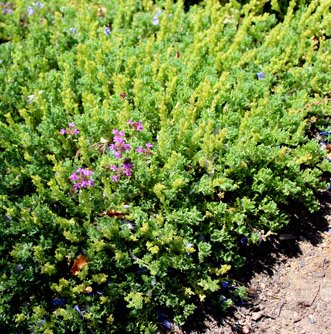 |
Thyme, 'Pink Chintz' - Thymus serpyllum 'Pink Chintz'
Description
"Thymus serpyllum, commonly called wild thyme, creeping thyme or mother-of-thyme, is a hairy, prostrate, creeping, woody-based perennial which is primarily grown as an ornamental ground cover. It is rarely used in cooking (Thymus vulgaris is the culinary thyme most commonly used in cooking). Wild thyme is native to Europe, western Asia and northern Africa. Numerous, thin, somewhat woody, prostrate stems clad with tiny, opposite, oval-rounded, pubescent, almost sessile, glossy blue-green leaves (to 1/4” long) form a flat foliage mat to 2-3” tall which will spread over time by rooting stems to 12-18” wide. Although leaves are aromatic (fragrance of mint), strength of scent varies according to season and habitat, and leaves are usually not considered to be of culinary quality. Dense inflorescences (primarily terminal but sometimes axillary) of tiny, tubular, bell-shaped, two-lipped, deep pink to purple flowers appear in summer (June-September) on erect flowering stems rising 2-4” tall. Flowers are attractive to bees.
Genus name comes from the Greek word thymos (name used in ancient Greece for a species of Thymus or Satureja).
Specific epithet from Greek means creeping in reference to the trailing growth habit of this species.
‘Pink Chintz’ has salmon-pink flowers and slightly woolly, dark olive green leaves." (missouribotanicalgarden.org)
 |
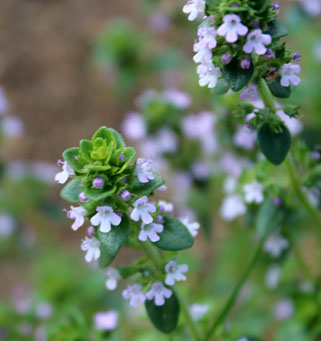 |
Thyme, Lemon - Thymus x citriodorus
Description
"Thymus × citriodorus, commonly called lemon thyme is primarily grown as a culinary herb for its rich, lemon-scented leaves. It is an erect, bushy, woody-based perennial which typically grows 4-12" tall with upward branching stems. Tiny, narrowly ovate, dark green leaves have a strong lemon scent which reaches its aromatic peak just before flowering. Leaves are frequently used fresh or dried (much better fresh) as a seasoning in a variety of culinary applications including salads, soups, stews, sauces, and meat or fish dishes. Fresh sprigs may be used as a garnish. Whorls of tiny, tubular, pale lilac flowers appear on the stem ends in early summer. Flowers are attractive to bees.
DNA testing shows that this plant is not a hybrid of T. vulgaris x T. pulegioides as often reported. It should probably be recognized as its own species, Thymus citriodorus.
Genus name comes from the Greek word thymos (name used in ancient Greece for a species of Thymus or Satureja).
Specific epithet means lemon-scented. (missouribotanicalgarden.org)
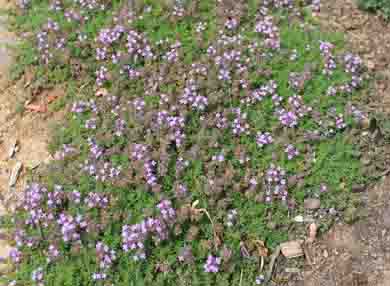 |
 |
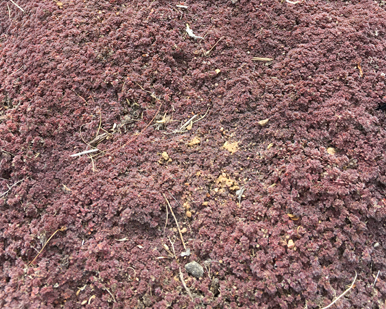 |
Winter color |
Thyme, Wooly - Thymus pseudolanuginosis
Description
"Thymus pseudolanuginosus, commonly called woolly thyme, is a creeping, woody based perennial which is used as a ground cover. Hairy stems (this is the woolliest of the thymes) give rise to the common name. Stems form a flat mat often no more than 1/2" tall but spreading to 12" wide. Very tiny, elliptic, gray leaves (to 1/8"). Leaves have little if any fragrance and are unsuitable for culinary use. Tiny, tubular, pale pink flowers appear in the leaf axils in summer in a somewhat sparse bloom. Flowers are attractive to bees.
Genus name comes from the Greek word thymos (name used in ancient Greece for a species of Thymus or Satureja).
Specific epithet means false-wool. It looks very much like wool but is not true wool, which, of course, comes from sheep (and other animals)." (missouribotanicalgarden.org)
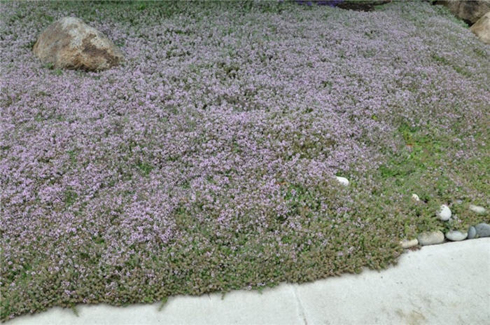 |
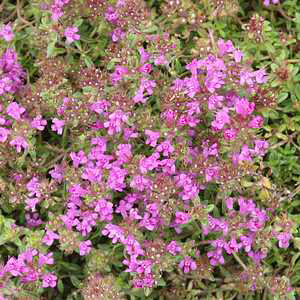 |
Thyme, Victor Reiter - Thymus 'Victor Reiter'
Description
"Reiter thyme is a tough, vigorous groundcover. Forms dense mats that can tolerate foot traffic and choke out most weeds. It grows to 3 inches tall and spreads 30 inches. Rich, olive green foliage is topped with lavender flowers in mid-summer. Faded flowers can be removed using a lawn mower. It has a pleasant, minty fragrance when crushed, though not considered for culinary uses. Attracts bees and butterflies." (slcgardenwise.com)
Internet Resources